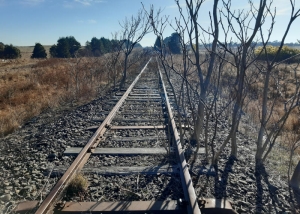Welcome to the Monaro Rail Trail Project
Monaro Rail Trail Inc
The association formed in August 2015 to promote the feasibility of developing a recreational cycle trail along the disused rail corridor from Queanbeyan to Bombala. Committee members are from communities along the route.
The Monaro Rail Trail
Recent Additions

President’s Report 2025 This year has been another busy one but perhaps one noted for the slow and incremental progress. The year began with the funding of the first section of trail at Bombala… Read more…

August 2025 Newsletter It seems a long time ago now, but in August 2015, the Monaro Rail Trail proposal became a formal organization – MRT Inc. Ten years later, has anything happened? Well yes. Bombala at the southern end of the proposed trail is the first point of construction and at the northern end, the Queanbeyan Palerang Regional Council has applied for funding to construct 20 km of trail. Meantime, some of the historic timber rail bridges in the rail corridor have been lost to demolition. However, interest in rail trails grows and, in this newsletter, we tell you of a new informal group of rail trail enthusiasts who have formed up to lobby not only for the nine RT proposals in southern NSW but for all RT proposals in NSW. Read more…

March 2025 Newsletter
Well, it’s all good news again. Both councils involved in the proposal have moved the project up their agenda.
Queanbeyan-Palerang council has applied for grant funding to commence construction of a 21km section. Also, we tell you how the rail trail will create a very appealing loop trail around the area.
From the Snowy Monaro Council, we learn that they will be reviewing the recently finished consultant’s reports.
Furthermore, down at Bombala, at the southern end of the proposed rail trail, Snowy Monaro Council is preparing final documentation for a start to trail construction.
Read more…

Monaro councils confirm support for the Monaro Rail Trail
On 20th February 2025, Snowy Monaro Regional Council resolved to reinstate investigations into the feasibility and potential future construction of the Monaro Rail Trail (MRT) Project. This decision has been welcomed by trail supporters throughout the region in recognition of the economic, recreation and social benefits the trail will bring to local communities. Read the Media Release
Glimpse the start of the Monaro Rail Trail
Bombala to Jincumbilly
Our Mission Statement
Our mission is to create Australia’s greatest rail trail where people of all ages and abilities can cycle, walk and run. It will see the wellbeing of local economies flourish through tourism bringing new business opportunities and preservation of the Monaro’s rich rail heritage.
About the proposed Monaro Rail Trail
The proposed rail trail follows the disused rail line from Queanbeyan to Bombala, a distance of 213 km. The first stage of the ride is through timbered country and up a gentle 3% gradient to get out of the Canberra valley. After that it’s a level but winding run to Cooma. From there the line moves through open country to cross the Great Dividing Range near Nimmitabel. Then it’s an easy downhill run through both timbered and open country to the trail end in the township of Bombala.
Along the way there are, cuttings and embankments, timber bridges over creek and river crossings, a 160 metre tunnel and heritage listed stations and freight yards. The rural landscape changes constantly along the route and throughout the seasons. Many Monaro residents believe they have a unique landscape to share.
It is envisaged that most of the trail would be a gravel surface and will be fenced across private land. Near Canberra and Queanbeyan it might be sealed as it could be part of the ACT urban cycle network.
This trail will appeal to many people. People living along the corridor will have easy access for short rides and there will be interstate and international tourists who want a longer ride, perhaps a weekend, perhaps a week. Either way everyone will be riding in a safe off road environment.
The trail represents a great opportunity to boost the region’s tourism economy and to directly stimulate village business trade.
Management of the trail will be done through a voluntary committee made up of stakeholders including business operators, local council and rural landholders.
